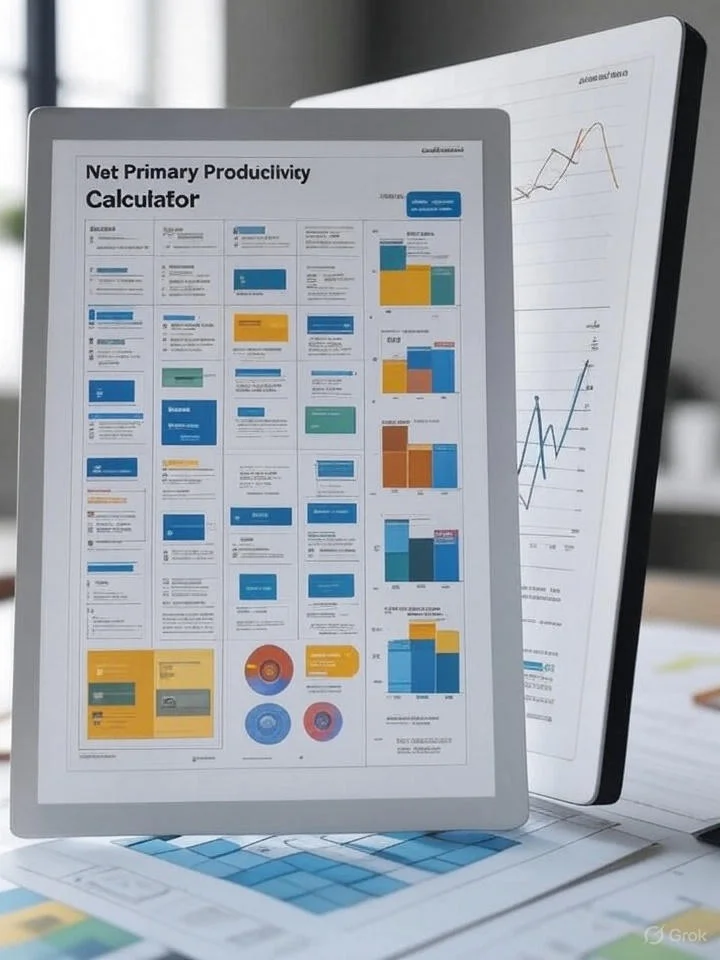Net Primary Productivity Calculator
Calculate the net primary productivity of an ecosystem based on photosynthesis and respiration rates
Photosynthesis Parameters
Typically ranges from 200-3000 g C/m²/year depending on ecosystem
Plant respiration, typically 40-70% of GPP
Additional Parameters (Optional)
Decomposer respiration, leave blank if unknown
Enter 1 for productivity per m²
NPP Calculation Results
Explore other calculators
- Productivity Calculator
- Productivity Percentage Calculator
- Healthcare Productivity Calculator
- Rehab Productivity Calculator
- Productivity Index Calculator
- Machine Productivity Calculator
What is Net Primary Productivity (NPP)?
Net Primary Productivity (NPP) represents the rate at which plants in an ecosystem produce useful chemical energy (in the form of biomass) after accounting for the energy used in plant respiration (R). It reflects the amount of energy available to herbivores and higher trophic levels in the food chain.
Formula: NPP = GPP – R
Where:
- GPP (Gross Primary Productivity) is the total energy produced through photosynthesis.
- R (Respiration) is the energy used by plants for metabolic activities.
Why is NPP Important?
NPP is a key ecological metric used by environmental scientists, ecologists, and conservationists to assess the health and productivity of ecosystems. It helps answer questions like:
- How much carbon is being sequestered by vegetation?
- How productive is a forest, grassland, or marine ecosystem?
- What is the impact of land use, climate change, or degradation on vegetation?
How to Use the Net Primary Productivity Calculator
Our Net Primary Productivity Calculator simplifies your work by letting you input the Gross Primary Productivity (GPP) and Respiration rate (R) to instantly calculate the NPP.
Input Parameters:
- GPP (in gC/m²/day or similar units): Total biomass generated by photosynthesis.
- R (in same units as GPP): Biomass lost through respiration.
Output:
- NPP: The remaining biomass available to support herbivores and the rest of the food chain.
💡 Tip: Make sure GPP and R are measured using consistent units for accurate results.

Real-World Applications of NPP
- Carbon Cycle Studies
NPP is used to estimate how much carbon is absorbed by vegetation—critical for understanding carbon sinks and climate change. - Land Management and Agriculture
Helps in evaluating crop yield, forest management, and rangeland productivity. - Remote Sensing
Satellite data from MODIS, NDVI, and other platforms can help estimate NPP across large landscapes using vegetation indices. - Ecological Modeling
Used in global and regional ecological simulations to predict productivity under different environmental conditions.
Manual Calculation Example
Let’s say:
- GPP = 2200 gC/m²/year
- R = 1200 gC/m²/year
NPP=2200−1200=1000 gC/m²/year\text{NPP} = 2200 – 1200 = 1000 \text{ gC/m²/year}NPP=2200−1200=1000 gC/m²/year
This means the ecosystem retains 1000 grams of carbon per square meter per year for the rest of the food web.
NPP vs GPP vs NEP – Don’t Get Confused!
| Term | Meaning | Formula |
|---|---|---|
| GPP | Total energy from photosynthesis | – |
| R | Energy used by producers | – |
| NPP | Energy available to herbivores | GPP – R |
| NEP (Net Ecosystem Productivity) | Net carbon accumulation in the ecosystem | GPP – (R<sub>plants</sub> + R<sub>heterotrophs</sub>) |
Factors Influencing Net Primary Productivity
Several variables affect NPP, including:
- Sunlight and Temperature
Warm, sunny climates often have higher productivity. - Water Availability
NPP is reduced in arid or drought-prone areas. - Soil Nutrients
Nitrogen, phosphorus, and potassium levels directly influence photosynthetic efficiency. - Seasonal Variation
Productivity varies with seasons in temperate ecosystems.
Remote Sensing and NPP Estimation
Modern ecology uses satellite data and NDVI (Normalized Difference Vegetation Index) to estimate GPP and, by extension, NPP over large regions. One widely used platform for accessing such satellite-derived data is NASA Earth Observations (NEO), which offers vegetation indices, solar radiation maps, and more.
Final Thoughts
- NPP is critical for understanding ecosystem energy flow and biomass accumulation.
- Use consistent units (like gC/m²/year) when inputting data. The higher the NPP, the more energy available to support biodiversity.
- Our calculator simplifies quick estimations for students, scientists, and land managers.
